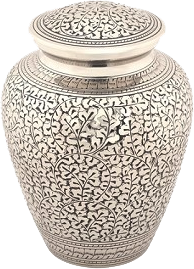Cremation Service
What is Cremation?
 Cremation is the process of reducing the body to bone fragments through the application of intense heat. This usually takes from two to three hours and occurs in a special type of furnace know as a cremation chamber or retort. The remaining fragments are then processed into a finer substance and placed in a temporary container. Before the remains are returned to the family, they are usually transferred to an urn for permanent containment. Cremation is often considered to be an inexpensive, less complicated substitute for the “traditional” funeral.
Cremation is the process of reducing the body to bone fragments through the application of intense heat. This usually takes from two to three hours and occurs in a special type of furnace know as a cremation chamber or retort. The remaining fragments are then processed into a finer substance and placed in a temporary container. Before the remains are returned to the family, they are usually transferred to an urn for permanent containment. Cremation is often considered to be an inexpensive, less complicated substitute for the “traditional” funeral.
Many people also believe that at the time of death, only two basic choices exist: immediate cremation of the body; or a complete funeral including viewing followed by burial. Actually, for those who prefer cremation, several options are available — perhaps even more than with burial. Cremation and burial are both defined as “modes of disposition,” or methods of caring for the body, and as such, are just one part of a funeral. Also, the term “traditional,” when applied to funerals, simply refers to an accepted trend of choices from the past. As times change, trends change too. Today, many opportunities exist for meaningful services for the benefit of family and friends — both before and after cremation takes place.
The Funeral Service and Cremation
Just like burial, cremation can occur after a funeral where the casket is present at one’s place of worship or a funeral chapel. The only real difference between a funeral followed by burial and one followed by cremation is that the body is taken to the crematory after the service in lieu of a procession to the cemetery. As is customary, the funeral may be preceded by a period of visitation or a reception at the funeral home.
During this time and before the service, the casket may be open or closed, according to the preferences of the survivors. Instead of a public visitation, some families opt to receive friends at their residence or other location, which is a matter of personal choice. Following the funeral, the body is cremated in the casket or placed in a special cremation container if a rental casket was selected. After cremation, a public or private service may be arranged for the final placement of the cremated remains.
The Memorial Service and Cremation
A memorial service, like a funeral, is a service of remembrance, but without the body present. It may be held at a place of worship, the funeral chapel or any other appropriate location. Regardless of the site, your funeral director will assist in planning and organizing the service, and will provide the necessary staff to direct the service. The urn may be present for the memorial service, as the casket would be for a funeral. It is usually placed on a stand and attractively arranged with flowers.
Sometimes a photograph of the person or a piece of meaningful memorabilia is displayed at the service or during the reception period. Depending on where the death occurred, state or provincial laws may require that a specific “waiting period” elapse before cremation can occur. When scheduling the memorial service, therefore, care should be taken to accommodate these requirements, to ensure that the cremated remains can be present at the service, if that is the preference of the family. Your funeral director can advise you on the regulations in effect in your area.
The family may hold a visitation or reception at the funeral home/mortuary with or without the presence of the body. Frequently, the body will be in the casket during this time for viewing, and then cremated before the memorial service. If cremation is t take place immediately following death, it is often possible to arrange a brief private time for the family to see the body prior to the memorial service. For many people, this has important psychological value, allowing them a time to “say good-bye.”
Direct Cremation
An immediate or direct cremation is limited to the prompt cremation of the body following death, with no formal funeral or memorial services. Some funeral firms will require a family member or authorized party to at least verify the identity of the deceased before cremation. In some jurisdictions, this is legally required as well. Your funeral director will assist in arranging this kind of service, providing personal attention and professional treatment.
Other Service Options
While these descriptions cover the general types of cremation services, your choices are not required to fit exactly into any particular category. There are literally “options within options” available to provide a meaningful service, and NSM funeral directors are dedicated to responding with openness and flexibility to the needs of each person or family they serve. They are fully equipped with facilities and personnel to accommodate special requests and offer a wide range of services and merchandise.
Pre-Arranging the Cremation Service
Pre-arrangement is a thoughtful method of funeral planning that is growing in popularity every year. some people do this with the sincere desire to avoid being a burden on their families. Others like the idea of “having taken care of everything,” and yet others may have no one else who can make arrangements for them. Pre-arrangement is also a wise choice when considering cremation. When death occurs, it is the next of kin who assumes primary responsibility for the disposition.